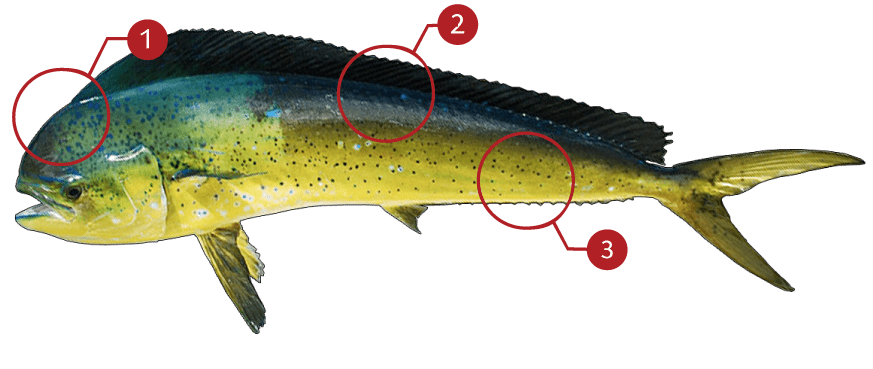MAHI-MAHI
How to identify a Mahi-Mahi (Dolphinfish)
The Mahi-Mahi is a distinctive fish, both for its shape and its colors. Though it is among the most colorful fish in the sea, the colors are quite variable and defy an accurate, simple description. Generally, when the fish is alive in the water, the Mahi-Mahi is rich iridescent blue or blue-green dorsally; gold, bluish gold, or silvery gold on the lower flanks; and silvery white or yellow on the belly. The sides are sprinkled with a mixture of dark and light spots, ranging from black or blue or golden. The dorsal fin is rich blue, and the anal fin is golden or silvery. The older fins are generally golden-yellow, edged with blue. When removed from the water, the colors fluctuate between blue, green, and yellow. After death the fish usually turns uniformly yellow or silvery gray. Large males have high, vertical foreheads, while the females’ forehead is rounded. Males grow larger than females.They are extremely fast swimmers and feed extensively on flying fish and squid as well as on other small fish. They have a particular affinity for swimming beneath buoys, seaweed, logs, and floating objects of almost any kind.
Where to catch Mahi-Mahi
The Mahi-Mahi can be found worldwide in tropical and warm temperate seas, the dolphinfish is pelagic, schooling, and migratory. Though occasionally caught from an ocean pier, it is basically a deep-water species, inhabiting the surface of the open ocean.
IDENTIFICATION

| |
Prominent foreheads protruding well above the central body line |
| |
Single dorsal fin extends from the top of the head, through the length of the body, almost to the tail |
| |
Body is compromised of a beautiful golden-green hue with iridenscent blue prectoral fins |
TARGET AREAS
|
|
Acknowledgements: We thank TAKEMEFISHING.org (www.takemefishing.org), Wisconsin Department of Natural Resources, Indiana Department of Natural Resources for their contributions to these FISH FACTS.

